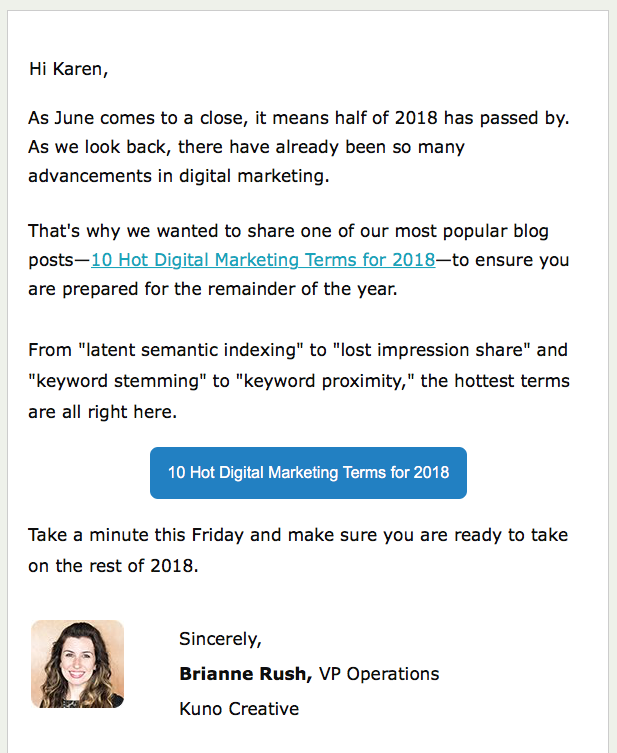On June 29th, I received a marketing email from one of my freelance clients. It included a link to a post I wrote in December for the agency’s blog, titled 10 Hot Digital Marketing Terms You Need to Know in 2018.
I contacted my client and learned that it was one of their most successful recent posts — so much so, that they repurposed it into an engagement and re-engagement tool six months later.
“This blog post garnered a lot of views in the months since it was published,” explained Brianne Rush, VP of Operations at Kuno Creative.
Results included steady increases in traffic flows that reached peak numbers in early June. Within a minute of the email being sent, traffic shot up to the highest point ever.
Based on the high long-tail reader volume the post generated, “we believe it stood out as an opportunity to re-engage with our database. We were right. When we sent an email about the post, many of our top prospects re-engaged with our website within minutes.
These were marketing-qualified leads (MQLs). In other words, people who had engaged with us before, and who were now inspired to return to our website thanks to the compelling blog post.”
Here’s the email that Kuno Creative sent to its MQL database to promote the blog post and engage/re-engage with its leads:
17 Topics Business People Want to Read
With a little research, I discovered a likely reason why my blog post was so successful in attracting readers and re-engaging with leads.
The post’s subject matter falls into one of the top 17 topics that business people want to read — “definitions and descriptions.” This topic works well, because people want clear explanations of whatever they are researching.
I came up with the idea for the blog post after creating a new glossary of digital marketing terms for the agency’s website. For the blog post, I pulled out 10 of the most timely and interesting terms, from artificial intelligence to quality score.
Little did I know then that this content would strike the right chord with readers.
Here is the entire list of the most popular topics that business people want to read identified by IMPACT. I’ve added links to interesting examples of each topic.
1. Cost — Business people want to know what things cost. Yet, many companies are afraid to print their prices. But, cost articles are “easy wins for traffic as well as conversions because they build trust.”
Cool cost example: How Much Does Content Marketing Cost?
2. “Best of” Lists — Basically, we all love ranking things and seeing how they stack up against others. Other words to use: fastest, easiest, strongest, most popular.
Cool “best of” list example: The NewsCred Top 50 Awards — Best Content Marketing Brands in 2018
3. Comparisons — It feels good to put things into neat little ranking order, and even better to let them “duke it out in a head-to-head match up.”
Cool comparisons example: 20 Comparison Infographic Templates and Data Visualization Tips
4. Pros & Cons — A twist on ordering and ranking information, which lets us determine whether the benefits of a product or service outweigh the drawbacks.
Cool pros & cons example: Content marketing vs advertising: which is best?
5. Benefits/Advantages of — Persuasive pieces that highlight the advantages of a product or service.
Cool “best of” list example: The Four Superpowers of Video Marketing
6. Your Problems — These posts address problems upfront, explain them in a better light, and provide solutions.
Cool your problems example: We Asked 1,000 Marketers: “What’s Your Biggest Challenge With Content?”
7. Their Problems — The buyer’s journey begins with a problem or pain your customers are experiencing. Reach out to them where they are.
Cool their problems example: How to Handle 8 Challenging Customer Service Scenarios
8. How-to/Tutorials — People don’t want to guess. They want you to tell them the in’s and out’s of using your products.
Cool how-to/tutorials example: How to Wow Your Audience with Branded How-To Tutorials
9. Correlation/Causation — Speaking of problems, readers want to know what’s causing them. They also want to be sure that a solution doesn’t lead to other problems.
Cool correlation/causation example: Spurious Correlations
10. Definition & Description — As I mentioned above, in my own example, people want clear explanations of whatever they are researching.
Cool definition & description example: 10 Hot Digital Marketing Terms You Need to Know in 2018
11. Types/Classifications — Categorizes products and services for easy understanding.
Cool types/classifications example: Content Classification & Organization in SharePoint
12. Qualifications — Provides an opportunity to educate your audience on what they should be looking for in high-quality products and services, thereby, positioning your company as the expert.
Cool qualifications example: Qualifications Summary — The Crown Jewel of Your Work Experience
13. Laws/Regulations/Requirements — Business people want to know about any laws related to your products and services.
Cool laws/regulations/requirements example: 3 Marketing Regulations You Should Know
14. Myths & Misconceptions — Clear the air once and for all on misinformation, rumors, and untruths.
Cool myths & misconceptions example: 5 Content Marketing Myths to Bust in 2018
15. Reviews — As part of their pre-purchase vetting process, business people typically look for product and service reviews.
Cool reviews example: 9 Customer Testimonial Examples That You Can Use on Your Website
16. Ideas/Trends — People want inspiration and guidance on products in which they are interested.
Cool ideas/trends example: 13 Biggest Content Marketing Trends that Will Dominate 2018
17. Timeline — Provides an opportunity to inform and set realistic expectations.
Cool timeline example: 20 Timeline Template Examples and Design Tips
Now that I know the topics that business people want to read, I’m looking forward to the opportunity to write blog posts on all of these compelling topics for my clients.
What results-driven content do you need today?

Dave Mink says
Hi Karen,
I am interested in learning more and costs for you services.